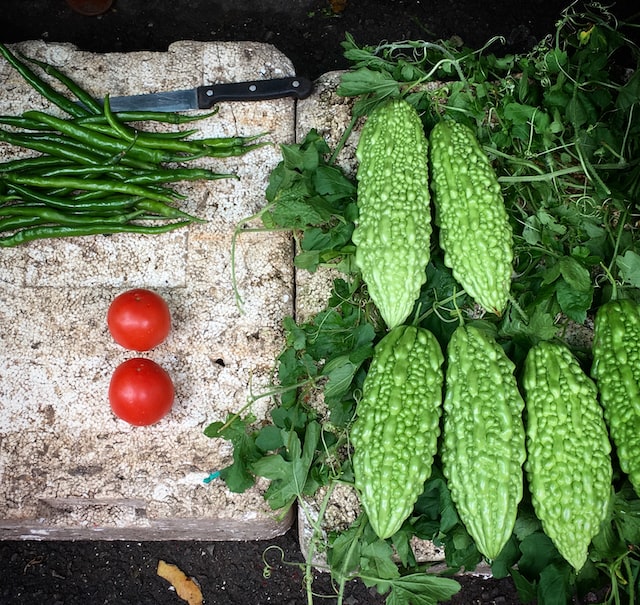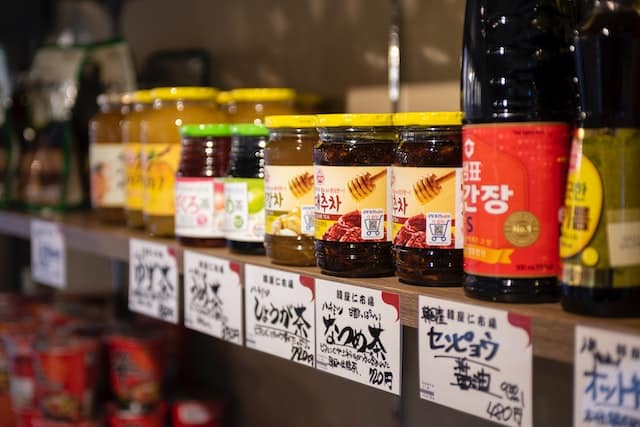150 Japanese Food Vocabulary [with Pronunciation and Translation]

Did you know that learning to cook in a foreign language is an amazing way to learn said language?
If you’re a foodie or just love to cook, memorizing Japanese words for food could be your shortcut to fluency. Learn 150 Japanese food words in my guide below to describe your favorite dishes.
Download: This blog post is available as a convenient and portable PDF that you can take anywhere. Click here to get a copy. (Download)
Ingredients: 食材 (shokuzai)
Fruit: 果物 (kudamono)
apple: りんご (ringo)
citron: 柚子 (yuzu)
柚子 is a Japanese citrus fruit most closely related to lemons, but with a sweeter and more floral taste. Once the hot weather hits, you’ll find 柚子 everywhere and in everything.
fig: 無花果 (ichijiku)
strawberry: 苺 (ichigo)
watermelon: 西瓜 (suika)
cucumber: きゅうり (kyūri)
grape(s): 葡萄 (budō)
Vegetables and Herbs: 野菜 (yasai) and ハーブ (hābu)
pumpkins: 南瓜 (kabocha)
mushrooms: 榎茸 (enoki dake)
eggplant: 茄子 (nasu)
carrot: 人参 (ninjin)
lotus root: 蓮根 (renkon) or 蓮 (hasu)
ginger: 生姜 (shōga)
bell pepper: ピーマン (pīman)
potato: じゃがいも (jagaimo)
いも by itself refers to tubers related to potatoes (like yams, sweet potatoes, taro root and so on). じゃがいも is one of the more common types. さつまいも are Japanese sweet potatoes: purple on the outside and yellow on the inside, unlike the American orange variety.
garlic: にんにく (ninniku)
perilla, Japanese mint: しそ (shiso)
Where we have peppermint, spearmint and regular mint in the States, they have しそ in Japan. The flavor is closer to spearmint, or even basil, than peppermint, and the herb is popularly served battered and deep-fried or wrapped up in red meat and grilled.
onion: 玉ねぎ (tamanegi)
scallion: ねぎ or 長ねぎ (negi) or (naga negi)
red pepper or chili pepper: 唐辛子 (tōgarashi) or パプリカ (papurika)
shishito pepper: 獅子唐 (shishi tō)
獅子唐 is a type of Japanese sweet pepper, like a small, green bell pepper. These are best grilled over charcoal.
Nuts and Grains: 木の実と穀物 (konomi to kokumotsu)
rice: 米 (kome)
uncooked rice: 米 (kome)
cooked rice: ご飯 (gohan) or 飯 (meshi)
As the Inuit are said to have many words for “snow,” Japan has many words for “rice.” Raw, uncooked grain is generally 米, and different strains of the crop are variations on that word. ご飯 and 飯 are the same word, pronounced differently.
sesame seeds: 胡麻 (goma)
walnuts: 胡桃 (kurumi)
oats: 麦 (mugi)
chestnuts: 栗 (kuri)
麦 also refers to barley and wheat.
Condiments: 調味料 (chōmiryō)
If you want to cook in Japan, some things you’ll definitely need in your kitchen are:
soy sauce: 醤油 (shōyu)
rice wine vinegar: みりん (mirin)
sesame oil: 胡麻油 (goma abura)
vegetable oil: サラダ油 (sarada abura)
water: 水 (mizu)
sauce: たれ (tare) or ソース (sōsu)
broth: 出汁 (dashi)
rice wine: 酒 (sake) or 日本酒 (nihonshu)
olive oil: オリーブ油 (orību abura)
salt: 塩 (shio)
black pepper: 胡椒 (koshō)
Japanese pepper: 山椒 (sanshō)
vinegar: 酢 (su)
mustard: 辛子 (karashi)
honey: 蜂蜜 (hachimitsu)
蜂蜜 is a compound of 蜂 , “wasp” or “bee,” and 蜜 , “nectar.” If you reverse the characters, 蜜蜂 (mitsubachi), you end up with “honeybee.” I’ll pass on the honeybee cake, thank you.
oyster sauce: オイスターソース (oisutāsōsu)
wine: ワイン (wain)
white wine: 白ワイン (shiro wain)
red wine: 赤ワイン (aka wain)
Animal Products: 畜産物 (chikusanbutsu)
When it comes to eating living things, Japan is far from squeamish. In some restaurants, they even serve fish sperm, which looks like mayo.
For meat eaters, the must-see spots are Japanese grills and chicken barbecue restaurants, where they’ll serve every part of any animal they can find.
gelatin: ゼラチン (zerachin)
egg: 卵 (tamago)
egg yolk: 卵黄 (ranō)
egg white: 卵白 (ranpaku)
milk: ミルク (miruku) or 牛乳 (gyūnyū)
condensed milk: 練乳 (rennyū)
mentaiko, seasoned pollack roe: 明太子 (mentaiko)
bonito flakes: かつお節 (katsuobushi)
unsalted butter: 無塩バター (muen batā)
salted butter: 有塩バター (yūen batā)
cream: 生クリーム (namakurīmu)
meat: 肉 (niku)
ground meat: ひき肉 (hikiniku)
chicken: 鶏肉 (toriniku)
chicken wings: 手羽先 (tebasaki)
chicken tender: ささ身 (sasami)
fish: 魚 (sakana)
mackerel: 鯖 (saba)
shrimp: 海老 (ebi)
oyster: 牡蠣 (kaki)
clam: あさり (asari)
pork: 豚肉 (butaniku)
beef: 牛肉 (gyūniku)
chicken gizzard: 砂肝 (sunagimo)
I once made the mistake of buying 砂肝. The name is a compound of 砂, “sand,” and 肝, “liver,” but I ended up completely ignoring the other half-dozen characters on the package, and I just zeroed in on “liver.”
I had never had chicken liver before! Imagine my disappointment when I bit into a piece of gizzard, the texture of which is diametrically opposite that of liver, and promptly tossed it all into the garbage.
pork bone: 豚骨 (tonkotsu)
豚骨 is the standard base for Japanese ramen, and it produces a rich, heavy, oily and milky broth… it’s like heaven in my mouth.
cartilage: 軟骨 (nankotsu)
quail: うずら (uzura)
Quail isn’t something you see every day, but in Japan they love quail eggs, うずらの卵 (うずらの たまご), and you’ll often find them steamed (like tea eggs) or grilled, skewered and wrapped in bacon.
sausage: ソーセージ (sōsēji)
tsukune: つくね (tsukune)
つくね is a Japanese meat ball, usually made from poultry instead of red meat.
Making Pastries: お菓子作り (okashizukuri)
There are traditional Japanese sweets, but Japan is far more enamored with French and German pastries, and everywhere you go, you’ll find a French patissier or a bread baker.
However, though European sweets are popular, baking at home is not and many people don’t have the space to bake (Japanese kitchens are small, and their ovens minuscule).
As a result, finding ingredients can be difficult, and finding them in appropriate quantities a pain.
agar-agar: 寒天 (kanten)
寒天 is a gelatin obtained from seaweed (and thus a good substitute in vegan baking), used in pastry as a binder and thickener.
granulated sugar: グラニュー糖 (guranyūtō)
brown sugar: 黒砂糖 (kurozatō)
light brown sugar: きび砂糖 (ki bi satō)
powdered sugar: 粉砂糖 (kona satō)
wheat flour: 麦粉 (mugiko) or 小麦粉 (komugiko)
Japanese flours, 麦粉, are named according to the amount of protein: “strong” refers to bread flour (強力粉, きょうりき こ), “medium” (中力粉, ちゅうりき こ) would be all-purpose and “weak” is cake or pastry flour (薄力粉, はくりき こ).
roasted soybean flour: きな粉 (kinako)
きな粉 is a nutty, flavorful, light brown flour used for dusting Japanese confections or adding flavor to sweets. It’s not the same as soy flour.
rice flour: 米粉 (komeko)
Like different types of 米, there are different types of 米粉: 餅粉 (もちこ) is a sticky rice flour used in making sticky rice buns, 餅 (もち), and often used in gluten-free baking. It can also be called 団子粉 (だんごこ). 玄米粉 (げんまいこ) is the brown, fibrous sister of 餅粉: brown rice flour.
amazake: 甘酒 (amazake)
甘酒 is sweet rice wine used in cooking or baking, or just drinking.
whole wheat flour: 全粒粉 (zenryūko)
almond flour: アーモンドプードル (āmondo pūdoru)
Not “poodle,” but poudre, from French.
potato starch: 片栗粉 (katakuriko)
cocoa powder: ココアパウダー (kokoa paudā)
yeast: イースト (īsuto)
baking powder: ベーキングパウダー (bēkingupaudā)
caramel: キャラメル (kyarameru)
vanilla essence: バニラエッセンス (banira essensu)
poppy seeds: 芥子粒 (keshitsubu)
cinnamon: シナモン (shinamon)
cardamom: カルダモン (karudamon)
star anise: 八角 (hakkaku) or アニス (anisu)
soy milk: 豆乳 (tōnyū)
sweet red bean paste: 餡子 (anko)
Counters: 助数詞 (josūshi)
teaspoon: 小さじ (kosaji)
tablespoon: 大さじ (ōsaji)
piece: 個 (ko)
This can be used for eggs, fruit or things that are generally just measured by numbers without amounts.
small piece, seed, drop: 粒 (tsubu)
can: 缶 (kan)
sheets, leaves: 枚 (mai)
slices/pieces (of meat): 切れ (kire)
sticks, stalks: 本 (hon)
This is the counter for long, round things like stalks of asparagus.
Preparation: 作り方 (tsukurikata)
To Cook: 料理をする (ryōri o suru)
to fry, grill, roast, bake: 焼く (yaku)
In the case of rice or noodles (“fried rice,” “stir-fried noodles” and so on), this means “to stir-fry” or “to pan fry.”
The next verb below is used with meat, vegetables and sautéing. 焼く is for baking pastries, frying pancakes or omelets, grilling, roasting in the oven, pan searing (steak, etc.) and the aforementioned stir-fried noodles and rice.
to stir-fry: 炒める (itameru)
to deep fry: 揚げる (ageru)
to steam: 蒸かす (fukasu)
to cut: 切る (kiru)
to heat: 熱する (netsu suru)
to pre-heat: 予熱をする (o suru)
to turn off the stove: 火を止める (hi o tomeru)
to mix together: 混ぜる (mazeru)
to serve: 盛り付ける (moritsukeru)
to grate (ginger, sesame seeds, etc.): 卸す (orosu)
to add: 加える (kuwaeru)
to boil: 茹でる (yuderu)
to stew, simmer, boil: 煮る (niru)
茹でる and 煮る both mean “to boil,” but the former implies cooking an object in boiling liquid: e.g., hard-boiled eggs, 茹で卵 (ゆでたまご). The latter means “to boil” or “to simmer” a liquid, either with the goal of reducing it (stews and braises) or cooking what’s inside.
to come to a simmer: 煮立つ (nitatsu)
煮立つ, is the intransitive verb: the stew “boils” or “comes to a simmer.”
Utensils/Tools 道具 (dōgu)
skillet: フライパン (furaipan)
knife: 包丁 (hō chō) or ナイフ (naifu)
rubber spatula: ゴムベラ (gomu bera)
strainer: こし器 (koshiki)
whisk: 泡立て器 (awadateki)
baking sheet or jelly roll pan: バット (batto) or オーブン用鉄板 (ōbunyō teppan)
parchment paper: オーブンシート (ōbun shīto) or クッキングシート (kukkingu shīto)
Let’s Cook!: 料理をしよう!(りょうりをしよう!)
Much of modern Japanese cooking is foreign-inspired, but all of it is simple. The recipe below is a personal favorite.
See if you can decipher the instructions with your new knowledge of food vocabulary! In some places, hiragana have been added in parentheses next to words, in order to give you a helping hand.
豚肉の生姜焼き
(butaniku no shōgayaki)
Ginger Pork
2人分 (ふたりぶん)
serves 2
食材
Ingredients
豚のロース肉 (ぶたの ろーす にく):250〜300g
The above is a thin slice of pork loin used for quick grilling and frying.
玉ねぎ:1/2 個
卸し生姜:大さじ2
醤油:大さじ2
酒:大さじ2
グラニュー糖:大さじ1
サラダ油:大さじ2
小麦粉:小さじ1
作り方
Directions
玉ねぎの皮 (かわ) をむき、半分 (はんぶん) にする。薄く (うすく) (5mmぐらい) 切る。
Remove the onion skin and cut the onion in half. Slice the onion thinly (about 5-millimeter slices).
生姜は、皮をむき、卸す。
Peel and grate the ginger.
バットに生姜、醤油、酒とグラニュー糖を入れて (いれて) 混ぜ、豚肉を広げて (ひろげて) 入れる。全部 (ぜんぶ) を混ぜ、約5分 (やく ごふん) 置いて (おいて) おく。
Put the ginger, soy sauce, rice wine and sugar into a small baking pan and mix it together. Spread the pork in the sauce and mix. Let it marinate for about 5 minutes.
フライパンにサラダ油を入れて、中火 (ちゅうび) で熱し、豚肉をざっと広げて入れる。
Heat the oil in the skillet on medium heat, and spread the pork out in the pan.
小麦粉も加え、そのまま2〜3分間 (に、さん ぷんかん) 焼き、肉の色 (いろ) が変わった (かわった) ら、玉ねぎも加える。
Add the flour and let the pork cook for 2-3 minutes, until the color starts to change, then add the onion.
バットに残っている (のこっている) たれを加え、弱火 (よわび) で焼き続ける (やきつづける)。
Pour in the remaining sauce from the baking pan, and continue cooking on low heat.
たれがほとんどなくなったら、盛り付ける。
When the sauce is almost all evaporated, turn off the heat and transfer the pork to a serving dish. (“Serve it.”)
How to Learn Japanese Through Cooking
Once you’re armed with a handy dandy dictionary, smartphone dictionary app or online translation tool, get yourself into the kitchen!
Actually, sit yourself down on the couch, with your computer. Let’s learn Japanese culinarily by:
- Getting a subscription to the Kawaii Box. It’s a sweet little box of Japanese cuteness that often contains one or two Japanese snacks, and sometimes a nifty little gadget that can be used for cooking, eating or playing with your food.
- Watching Japanese variety shows. They talk about food a lot. Rachel Ray’s not so popular, but they have their own share of cooking segments.
- Reading food blogs, like Ruu No Oishii Gohan, Sake To Ryouri or Cafe&Meal Muji. By following Japanese bloggers, we’ll feed two birds with one stone fruit: learning the language and learning to cook!
- Perusing a Japanese recipe database, like Rakuten Recipes, Gourmet Navigator (GuruNavi) or Japanese CookPad.
- Filling up our shopping carts with Japanese cookbooks.
If you prefer getting instructions directly in Japanese with interactive subtitles, you can do so on FluentU, a language learning program.
FluentU takes authentic videos—like music videos, movie trailers, news and inspiring talks—and turns them into personalized language learning lessons.
You can try FluentU for free for 2 weeks. Check out the website or download the iOS app or Android app.
P.S. Click here to take advantage of our current sale! (Expires at the end of this month.)

どうぞお召し上がりください!
Bon appétit!
Download: This blog post is available as a convenient and portable PDF that you can take anywhere. Click here to get a copy. (Download)
And One More Thing...
If you love learning Japanese with authentic materials, then I should also tell you more about FluentU.
FluentU naturally and gradually eases you into learning Japanese language and culture. You'll learn real Japanese as it's spoken in real life.
FluentU has a broad range of contemporary videos as you'll see below:

FluentU makes these native Japanese videos approachable through interactive transcripts. Tap on any word to look it up instantly.

All definitions have multiple examples, and they're written for Japanese learners like you. Tap to add words you'd like to review to a vocab list.

And FluentU has a learn mode which turns every video into a language learning lesson. You can always swipe left or right to see more examples.

The best part? FluentU keeps track of your vocabulary, and gives you extra practice with difficult words. It'll even remind you when it’s time to review what you’ve learned. You'll have a 100% personalized experience.
Start using the FluentU website on your computer or tablet or, better yet, download the FluentU app from the iTunes or Google Play store. Click here to take advantage of our current sale! (Expires at the end of this month.)
















